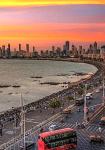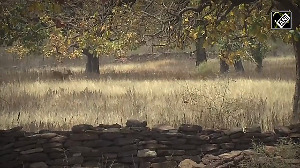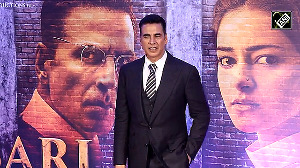Today will be a red-letter day for the Indian aeronautics industry as Prime Minister Atal Bihari Vajpayee christens the supersonic Light Combat Aircraft and rolls out its first pilot vehicle in Bangalore.
It will also be the first time that the prime minister will witness a flight display of the LCA's two prototypes, Technology Demonstrator I and Technology Demonstrator II, which have already made several successful test flights in the last two years.
"We are waiting for the prime minister to pick one of the 20 Sanskrit names shortlisted," Air Marshal Philip Rajkumar told rediff.com on Saturday. Some of the names such as Garuda, Jataayu, and Teer have their roots in Hindu mythology and the epics of Ramayan and Mahabharat.
"A decision has been taken to give Indian names to all indigenously developed military hardware and the move to christen the LCA is part of that process," Air Marshal Rajkumar, director of the Aeronautical Development Agency in Bangalore, said.
Group Captain Rakesh Bhaduria will fly the TD-I, while Squadron Leader Sunit Krishna will fly the TD-II. They will also exhibit special manoeuvres with the new aircraft to the select gathering.
"After the two prototypes are flown for 10-15 minutes, the four variants of the Advance Light Helicopter will be airborne. It will be followed by a demonstration flight of the Intermediate Jet Trainer, designed and developed by HAL," the air marshal said. Squadron Leader Baldev Singh will fly the IJT.
Four variants of the indigenously built ALH have already been inducted into the three defence services (army, air force, and navy) and the Coast Guard. Defence Minister George Fernandes christened the ALH Dhruv, which is the Indian name for the Pole Star, and is also the name of an ancient sage.
Later, Vajpayee will roll out the LCA's first pilot vehicle (PV-I), which will take to the skies in July this year.
The PV-I is lighter than the two prototypes with modifications in its fuselage, the ADA director said. Its composite materials are more sophisticated while its avionics and electronics have been upgraded for test flights later this year by air force pilots.
Besides Vajpayee, Fernandes, Chief of Air Staff S Krishnaswamy, Fernandes's scientific adviser Dr V K Aatre, and other dignitaries will witness the flying display. Deputy Prime Minister Lal Kishenchand Advani, who will be in Bangalore on Sunday for another function, is also likely to witness the demonstrations of the LCA, ALH, and IJT.
Designed and developed by the ADA in collaboration with the Defence Research and Development Organisation and Hindustan Aeronautics Limited, the LCA will go into a limited series production of six aircraft and become operational by 2007.
Phase I of the project is likely to cost Rs 2,188 crore (approximately US $460.62 million). The cost of production and weapon systems will be factored in under phase II during the current five-year plan.
"The weapons-graded LCA will be inducted into the IAF during 2007-08," Air Marshal Rajkumar said. "It is being built to carry a weapon load of 4 tons, including air-to-air missiles and air-to-ground munitions."
Conceived in 1983, the LCA project has had a very long gestation period with several extensions. The project was delayed further because of sanctions imposed by the US in the wake of the May 1998 nuclear tests.
With the lifting of sanctions after September 11, 2001, American firms have resumed collaboration with Indian defence organisations to provide avionics, electronics, and engines for the fighter aircraft.
According to HAL chairman N R Mohanty, the cost of basic capital equipment for limited production of six LCAs will be about Rs 100 crore (US $21.05 million).
The LCA is meant to replace the ageing fleet of Soviet-era MiG-21s, which have a poor flight-safety record and have been nicknamed 'flying coffins' because of the number of crashes in recent years.







 © 2025
© 2025